child seat AUDI S4 2014 Owners Manual
[x] Cancel search | Manufacturer: AUDI, Model Year: 2014, Model line: S4, Model: AUDI S4 2014Pages: 296, PDF Size: 73.56 MB
Page 5 of 296
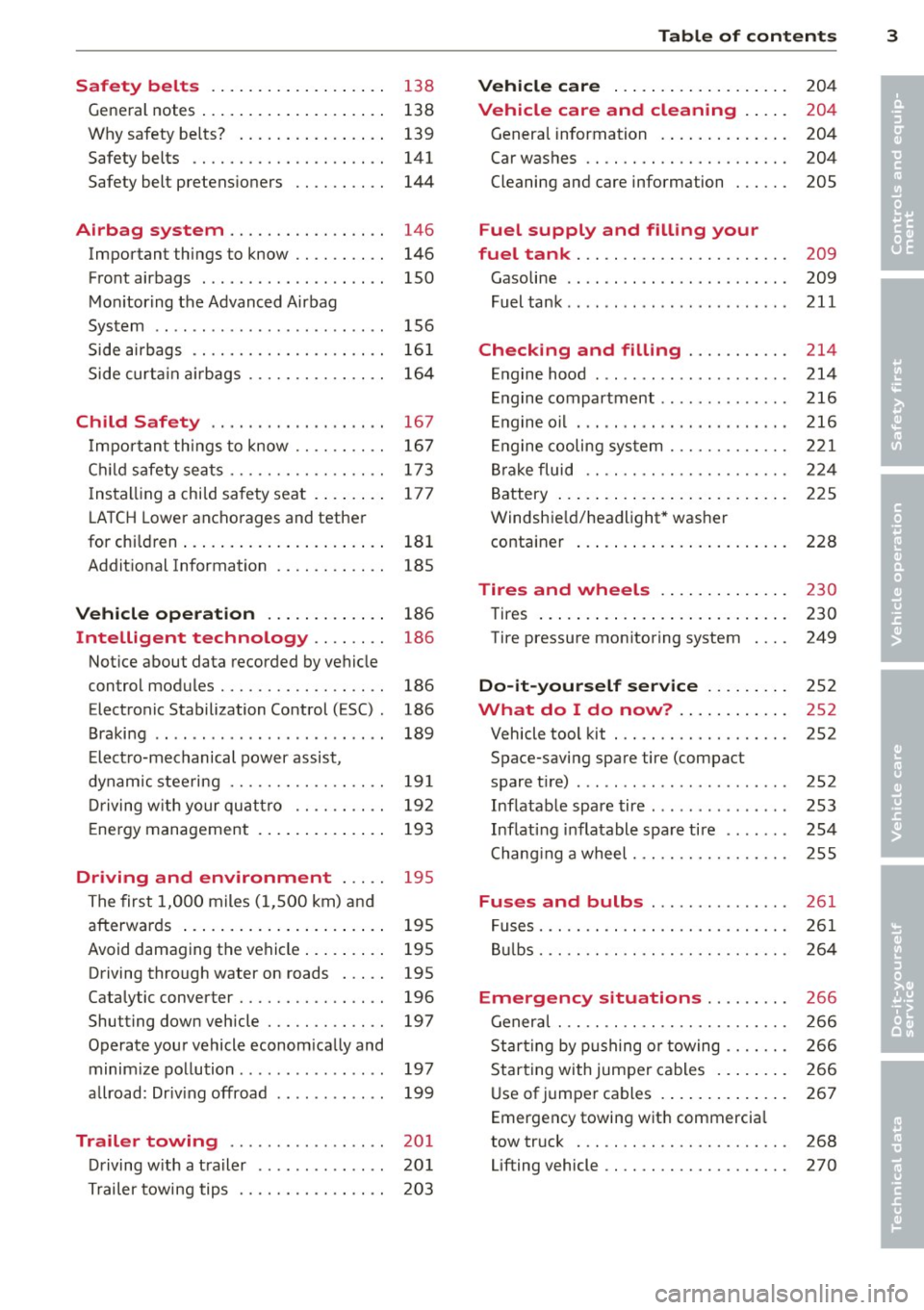
Safety belts . . . . . . . . . . . . . . . . . . . 13 8
General notes . . . . . . . . . . . . . . . . . . . . 138
Why safety be lts? . . . . . . . . . . . . . . . . 139
Safety belts . . . . . . . . . . . . . . . . . . . . . 141
Safety belt pretens ioners . . . . . . . . . . 144
Airbag system ................ .
Important things to know ......... .
Front airbags ................... .
Mon itor ing the Advanced Airbag
System ........................ .
Side airbags ............. .... .. . .
Side curta in a irbags .............. .
Child Safety ........ .... ... .. . .
Impor tant things to know ......... .
C hi ld safety sea ts ................ .
I nstall ing a chi ld safety seat . ... .. . .
L A T CH Lower anchorages and tether
for children ... .... .... ... .. .. .. . .
Addit ional Information
Vehi cle operat ion ..... .. .. .. . .
Intelligent technology .. .. .. . .
Not ice about data recorded by vehicle
control modules .......... .... .. . .
Electronic Stabilization Control (ESC) .
Braking .. ... ................ ... .
E lect ro-mechanical power assist ,
dynamic stee ring ................ .
Driving w ith your qu attro ......... .
E ne rgy management ... ... .. .. .. . .
Driving and environment ... ..
The first 1,000 miles (1,500 km) and
afterwards ... ... ..... ... .. .. .. . .
Avoid damaging the vehicle ... .. .. . .
Driving through water on roads ... . .
Catalytic converter .......... .. .. . .
Shutting down vehicle ............ .
Operate your vehicle econom ically and
minim ize pollution ............... .
a llroad: Driv ing offroad ........ ... .
Trailer towing ... ... ... .. .. .. . .
D riving w ith a t railer ............. .
Trailer towing tips ........ .... .. . . 146
146
150
156
16 1
164
167
167
173
17 7
18 1
185
186
186
186
186
189
19 1
19 2
193
195
195
195
195
196
197
197
199
20 1
20 1
203
Table of contents 3
Vehicle care . . . . . . . . . . . . . . . . . . .
204
Vehicle care and cleaning . . . . . 204
Genera l information . . . . . . . . . . . . . . 204
Car washes . . . . . . . . . . . . . . . . . . . . . . 204
Cleaning and care information . . . . . . 205
Fuel supply and filling your
fuel tank ..... .. .. . ............ .
Gasoline .. .. .. .... ..... ..... ... .
Fuel tank .. .. .. .. .. . .. .... ...... .
Checking and filling .......... .
Engine hood ... ... .............. .
Engine compartment ............. .
E ngine oil . .. .. .. ... .. .. ..... ... .
E ngine cooling system ............ .
B rake fluid .. .. .. .. . ............ .
Battery ... .. .... .. . .. .. ..... ... .
Windshie ld/headlight* washer
container ... .... ... .. .. ..... ... .
Tires and wheels ... ..... ... .. .
Tires ... .. .. .. .... . ... ...... ... .
Tire pressure monitoring system
Do-it-yourself service ...... .. .
What do I do now? ...... ... .. .
Vehicle tool kit . ...... ........... .
Space-saving spare tire (compact
spare tir e) .... ... .. ............. .
Inflatable spare tire .............. .
Inflat ing i nflatable spa re tire ...... .
Changi ng a wheel . .... ........... .
Fuses and bulbs ...... ........ .
Fuses ..... .... .. .. . ............ .
B ulbs ..... .. .. .. .. .. ........... .
Emergency situations ........ .
Genera l ... .. .. .. ............... .
St art ing by p ushing or towing ...... .
Star ting with jumpe r cables .. ... .. .
Use of jumper cables . .. ..... ... .. .
Emergency towing wit h commercia l
tow truck ... .. .. .. .. ........... .
Lifting vehicle .. .. ............... . 209
209
211
214
214
216
216
2
21
224
225
228
2 3 0
230
249
252
252
252
252
253
254
255
261
2 61
264
2 66
2 66
2 66
266
267
268
270
•
•
Page 36 of 296
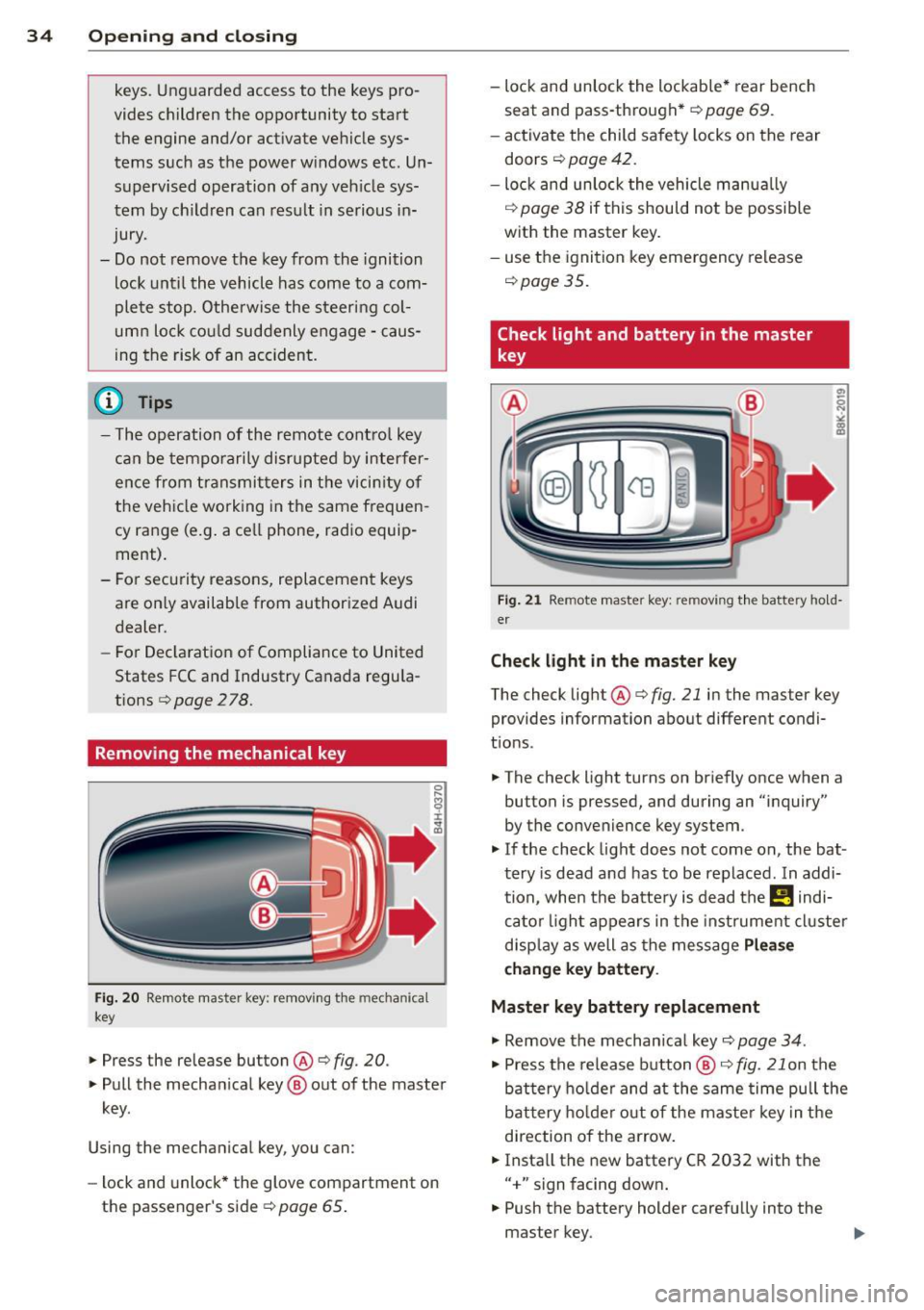
34 Openin g and clo sing
keys. Unguarded access to the keys pro
vides children the opportunity to start the engine and/or act ivate vehicle sys
tems such as the power w indows etc . Un
supervised operation of any veh icle sys
tem by ch ildren can res ult in serious in
Jury.
- Do not remove the key from the ignition
lock until the vehicle has come to a com
plete stop. Otherwise the steering col
um n loc k co uld suddenly e ngage -caus
ing the risk of an accident.
@ Tips
- The operation of the remote contro l key
c a n be tempo rarily disrupted by in terfer
ence from tran smi tters in t he v ici nity of
the veh icle work ing in the same frequen
cy ra nge (e.g . a ce ll phone, radio equip
ment).
- Fo r security reasons, replacement keys
are on ly available from author ized Audi
dealer.
- For Decla ration of Compliance to United
States FCC and Industry Canada regu la
tions
c:> page 2 78.
Removing the mechanical key
F ig . 20 Remote ma ster key : remov ing the mec hanic al
key
" Press the release button ® c:> fig. 20 .
"Pull the mecha nica l key @out of the maste r
key .
Using the mechan ica l key , you can :
- lock and unlock* the glove compartment on
the passenger's side ¢
page 65.
-lock and unlock the lockable* rear bench
seat and pass-through *
c:> page 69.
- activate the child sa fe ty locks on the rear
doors
c:> page 42 .
-lock and unlo ck the vehicle manu ally
¢
page 38 if this should not be possible
with the master key.
- use the ignition key emergency release
¢ page 35.
Check light and battery in the master
key
Fig . 2 1 Re mote mas te r ke y: r em ov ing th e batte ry hold
e r
Check light in the master key
The check light@¢ fig. 21 in the master key
provides information about different condi
t ions .
" The check light tu rns on br iefly once when a
button is pressed, and during an "inquiry"
by the convenience key system .
" If the check light does not come on, the bat
tery is dead a nd has to be replaced . In addi
tion, when the batte ry is dead
the m indi
ca to r li ght appears in the instr ument cluster
disp lay as well as the message
Plea se
change key battery .
Master key battery replacement
" Remove the mechan ica l key ¢ page 34 .
" Press the release button @ ¢fig. 21 on the
bat tery ho lde r and at the same time pull the
ba ttery holde r o ut o f the maste r key in the
di rection o f the arrow.
" Insta ll the new battery CR 2032 with the
"+ " sign facing down .
... Push the battery holder carefu lly into the
master key .
Page 43 of 296
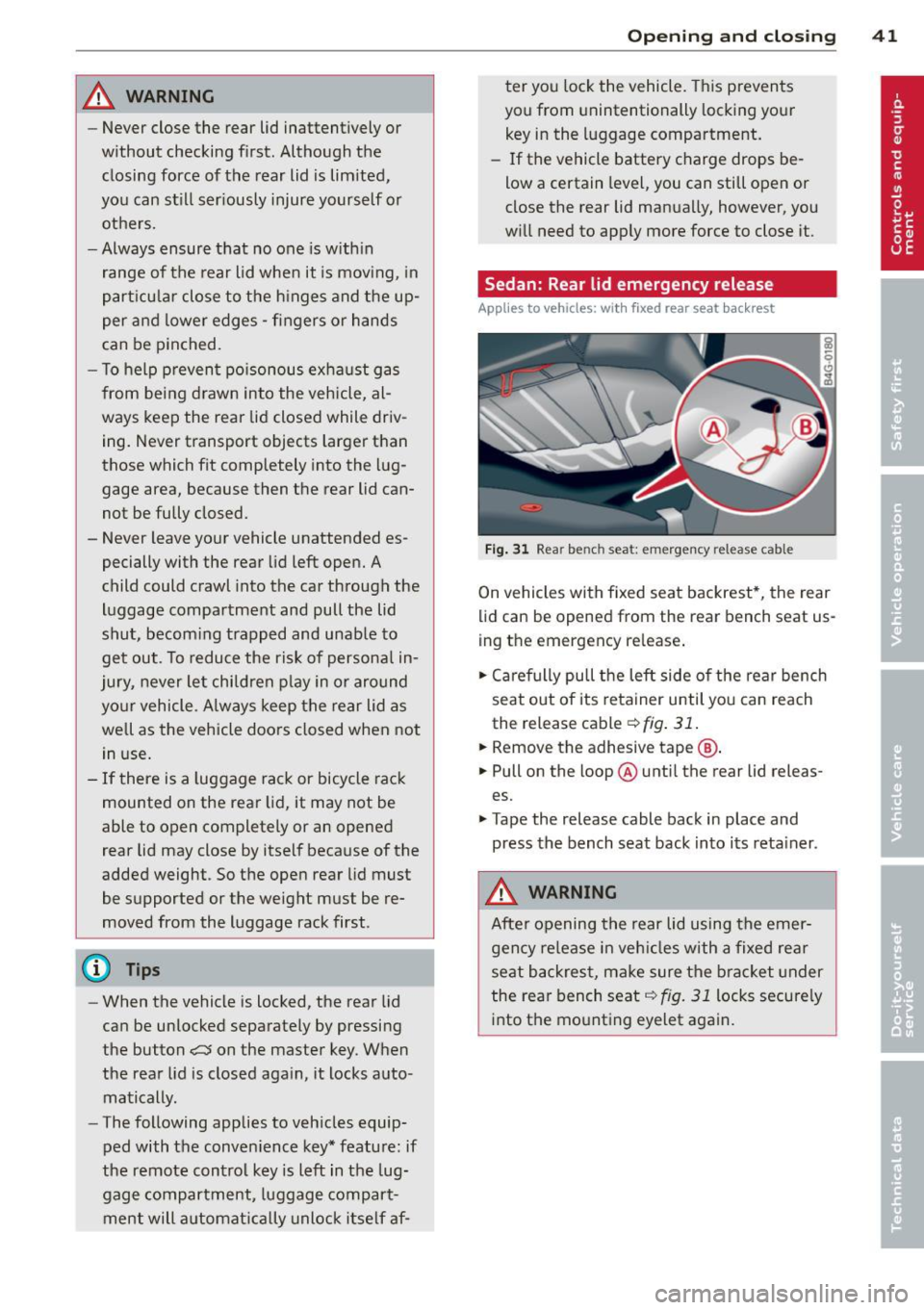
_& WARNING
-Never close the rear lid inattentively or
without checking first. Although the
closing force of the rear lid is lim ited,
you can stfll seriously injure yourself or
o the rs.
- Always ensure that no one is w ithin
range of the rear lid when it is mov ing, in
part icu lar close to the hinges and the up
per and lower edges -fingers or hands
can be pinched.
- To help preven t po isonous exha ust gas
from being drawn into the vehicle, al
ways keep the rear lid closed while driv
ing. Never transport objects larger than
those which fit completely into the lug gage area, because then the rear lid can
not be fully closed.
- Never leave your vehicle unattended es pecially with the rear lid left open. A
child could crawl into the car through the
luggage compartment and pull the lid
shut, becom ing trapped and unab le to
get out. To reduce the risk of persona l in
jury, never let children p lay in or around
yo ur vehicle. A lways keep the rear lid as
well as the vehicle doors closed when not
in use .
- If there is a luggage rack or bicycle rack
mounted on the rear lid, it may not be
able to open completely or an opened
rear lid may close by itself because of the
added weight. So the open rear lid must
be supported or the weight must be re
moved from the luggage rack first .
@ Tips
-When the vehicle is locked, the rear lid
can be unlocked separately by pressing
the button
~ on the master key. When
the rear lid is closed aga in, it locks auto
matically.
- The following applies to veh icles equip
ped with the conve nience key* feature: if
the remote contro l key is left in the lug
gage compartment, luggage compart ment will a utomat ica lly unlock itse lf af-
Op enin g an d clos ing 41
ter you lock the vehicle. This prevents
you from unintentionally locking your
key in the l uggage compartment.
- If the vehicle battery charge drops be
low a certain level, you can still open or
close the rear lid manually, however, you
w ill need to apply more force to close it.
Sedan: Rear lid emergency release
Applies to vehicles: with fixed rear seat backrest
F ig . 31 Rea r be nch seat: em ergency release cab le
On vehicles with fixed seat backrest *, the rear
lid can be opened from the rear bench seat us
ing the emergency re lease .
.,. Ca re fully pull the left side o f the rear bench
seat out of its retainer until you can reach
the release cable
¢ fig . 31 .
.,. Remove the adhesive tape @.
.,. Pull on the loop ® until the rear lid releas
es.
.,. Tape the release cable back in place and
press the bench seat back into its reta iner.
_& WARNING
After opening the rear lid using the emer
gency re lease in veh icles with a fixed rear
seat backrest, make sure the bra cket under
the rear bench seat
¢ fig. 31 locks secure ly
into the mounting eyelet again.
Page 60 of 296
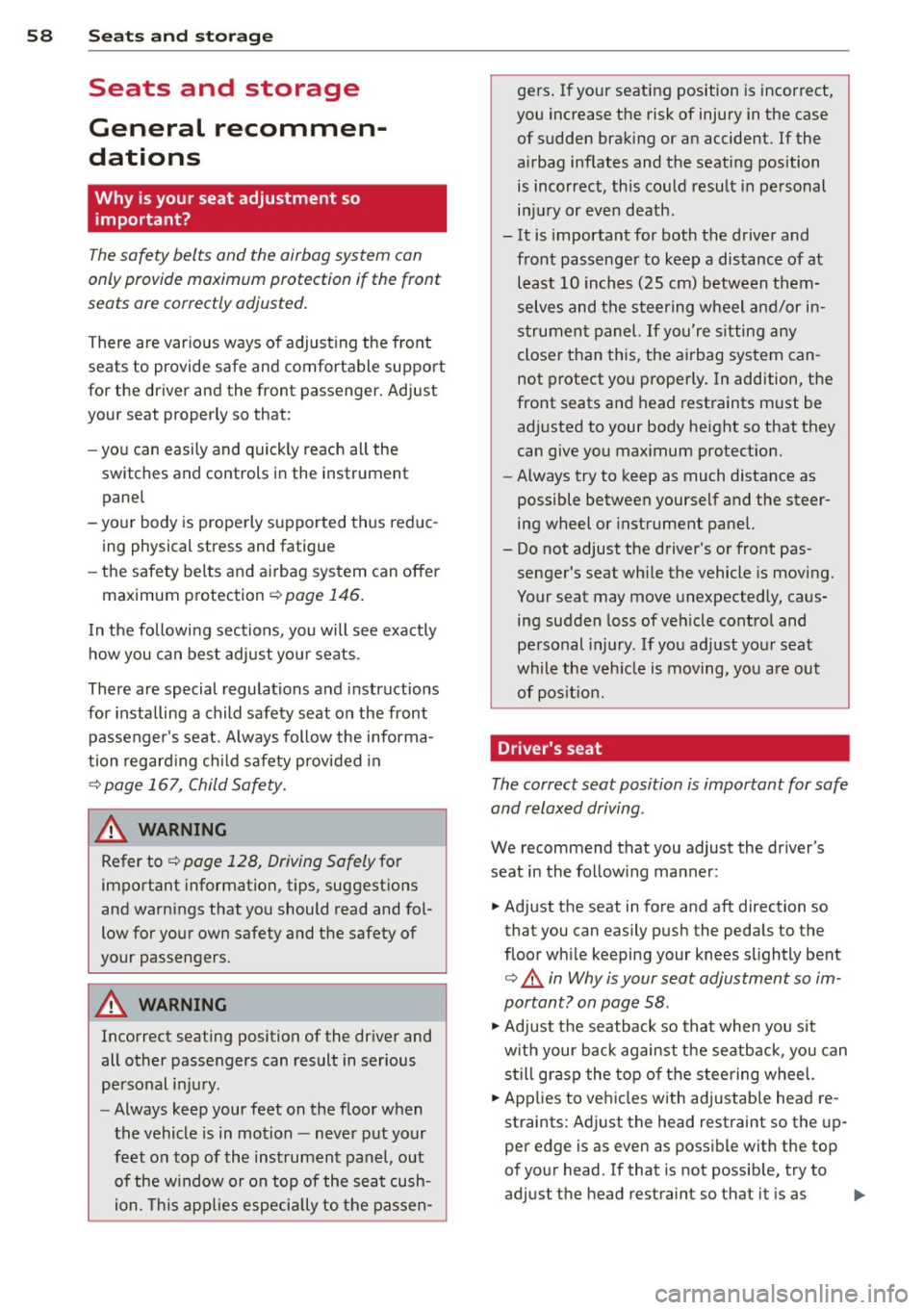
58 Seat s a nd s tor ag e
Seats and storage
General recommen
dations
Why is your seat adjustment so
important?
The safety belts and the airbag system can
only provide maximum protection if the front
seats are correctly adjusted.
There are various ways of adjust ing the front
seats to provide safe and comfortable support
for the driver and the front passenger . Adjust
your seat properly so that :
- you can easily and quick ly reach all the
switches and controls in the instrument
panel
-your body is prope rly supported thus reduc
ing physical stress and fatigue
- the safety be lts and a irbag system can offer
maximum protection ¢
page 146.
In the following sec tions, you will see exactly
how you can best adjust you r seats .
There are special regulations and instructions
for insta lling a child safety seat on the front
passenger's seat. Always follow the informa
tion rega rd ing child safety provided in
G page 167, Child Safety.
WARNING
Refer to G page 128, Driving Safely for
important information, tips, suggestions
and warnings that you should read and fol
low for your own safety and the safety of
your passengers.
A WARNING
, -
Incorrect seating position of the dr iver and
all other passengers can result in serious
personal inj ury .
- Always keep your feet on the f loor when
the vehicle is in mo tion -never put your
feet on top of the instrument panel, out of the w indow or on top of the seat cush
ion. This app lies especially to the passen- gers
. If your seating position is incorrect,
you increase the risk of injury in the case of sudden braking or an accident. If the
airbag inflates and the seating position is incorrect, this could result in pe rsonal
in ju ry or even death.
- It is important for both the driver and front passenge r to keep a distance of at
least 10 inches (25 cm) between them
selves and the steering wheel and/or in
s trumen t panel.
If you're s itting any
closer than th is, the a irbag system can
not protect you properly. In addition, the
front seats and head restraints m ust be
adj usted to your body height so that they
can give you max imum protect ion.
- Always try to keep as much distance as
possible between yourself and the steer
ing wheel or instrument panel.
- Do not adjust the driver's or front pas senger's seat while the vehicle is moving.
Your seat may move unexpected ly , caus
ing sudden loss of veh icle control and
pe rsonal injury. If you ad just you r seat
while the veh icle is moving, yo u are out
of posit ion.
Driver's seat
The correct seat position is important for safe
and relaxed driving .
We recommend that you adjust the dr iver's
seat in the follow ing manner:
.. Adjust the seat in fore and aft direction so
that you can easily push the pedals to the
floor wh ile keeping your knees slightly bent
G &. in Why is your seat adjustment so im
portant? on page 58 .
.,. Adj ust the seatback so that when you s it
w ith your back against t he seatback, you can
s till grasp the top of the steering whee l.
.. App lies to ve hicles w ith ad justable head re
straints: Adjust the head restraint so the up
pe r edge is as even as possible with the top
of yo ur head. If that is not possib le, try to
adjust the head restraint so that it is as .,.
Page 64 of 296
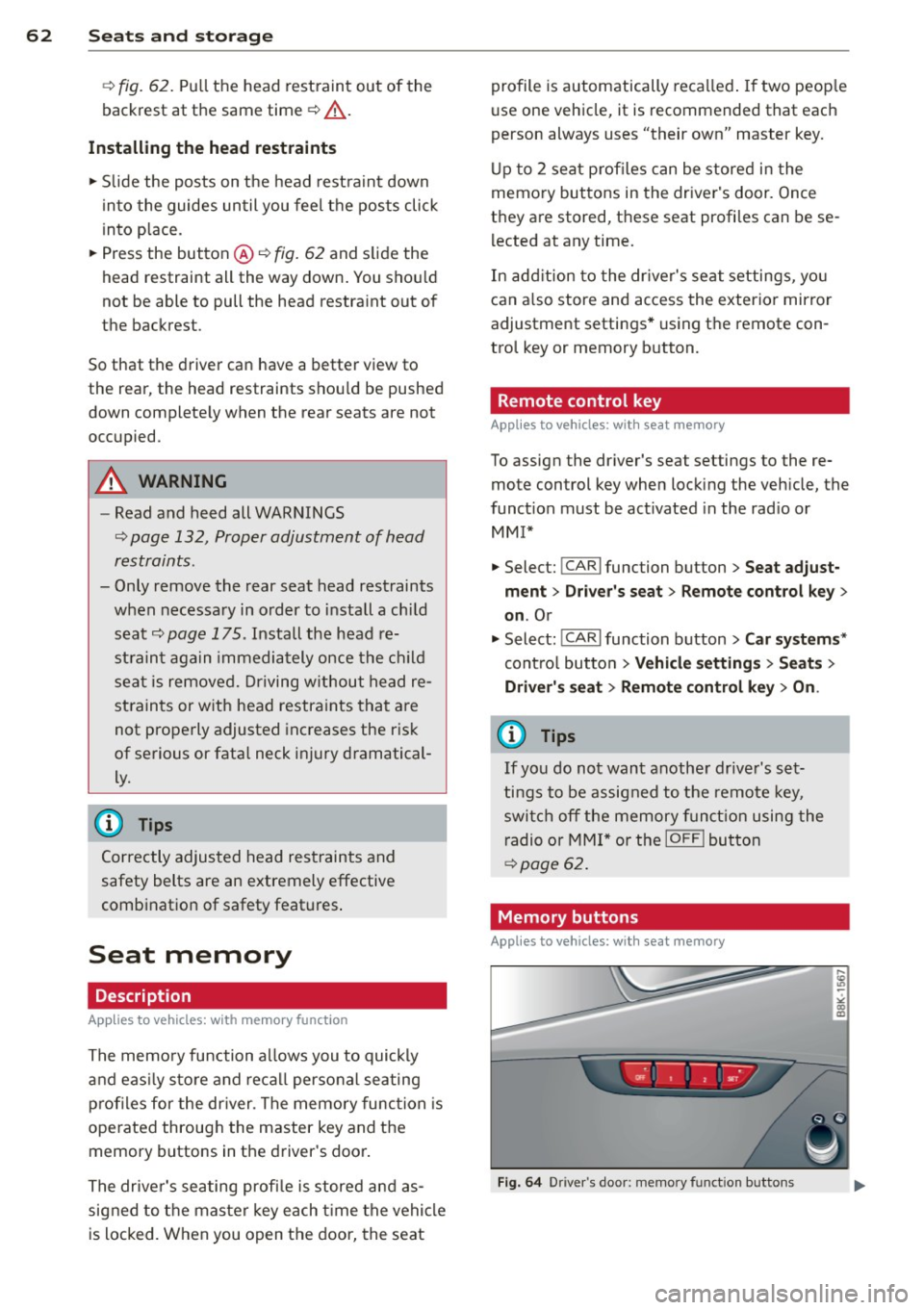
62 Seats and storage
r:!vfig. 62. Pull the head restraint out of the
backrest at the same time¢
,A.
Installing the head restraints
.. Slide the posts on the head rest raint down
into the guides until you feel the posts click
into place.
.. Press the button @
<::?v fig. 62 and slide the
head restraint all the way down. You shou ld
not be able to pull the head restraint out of
the backrest.
So that the driver can have a better view to
the rear, the head restraints shou ld be pushed
down complete ly when the rear seats are not
occupied.
A WARNING
- Read and heed all WARNINGS
r:!v page 132, Proper adjustment of head
restraints.
- Only remove the rear seat head restraints
when necessary in order to install a child
seat¢
page 175. Install the head re
straint again immediately once the child
seat is removed. Driving without head re
straints or with head restraints that are
not properly adjusted increases the risk
of serious or fata l neck injury dramatical
ly.
(D Tips
Correctly adjusted head restraints and
safety belts are an extremely effective
combination of safety features .
Seat memory
Description
Applies to vehicles: with memory function
The memory function allo ws you to quickly
and easily store and reca ll personal seating
p ro files for the driver. The memory function is
ope rated through the master key and the
memory buttons in the driver's door.
The driver's seating profile is stored and as
signed to the master key each time the vehicle
is locked. When you open the door, the seat profile
is automatically recalled. If two peop le
use one vehicle, it is recommended that each
person always uses "their own" master key.
Up to 2 seat profiles can be stored in the
memory buttons in the drive r's door. Once
they are stored, these seat profiles can be se
l ected at any time .
In addition to the driver's seat settings, you
can a lso store and access the exterior mirror
adjustment settings* using the remote con
trol key or memory button.
Remote control key
Applies to vehicles: wit h seat memory
To assign the driver's seat settings to the re
mote control key when locking the veh icle, the
function must be activated in the rad io or
MMI*
.. Select:
!CARI function button > Seat adjust
ment > Driver's seat > Remote control key
>
on.Or
.. Select : !CARI function button> Car systems*
cont ro l button > Vehicle settings > Seats >
Driver's seat> Remote control key> On .
@ Tips
If you do not want another driver's set
tings to be assigned to the remote key,
switch off the memory function using the
radio or
MMI* or the IOFFI button
¢page 62.
· Memory buttons
Appl ies to vehicles: wit h seat memory
Fig. 64 Driver's door: memory function buttons
Page 65 of 296
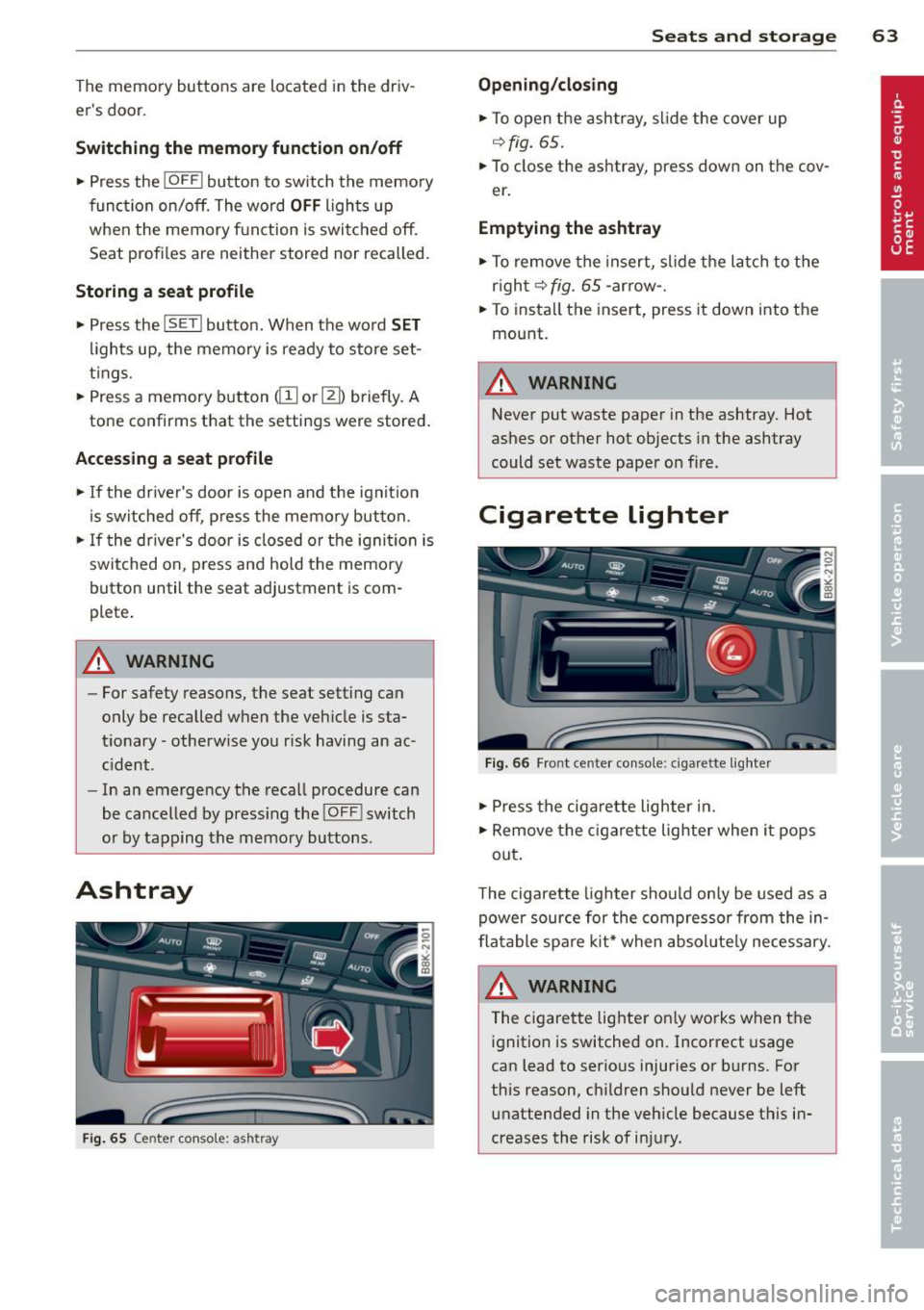
The memory buttons are located in the driv
er's door.
Switching the memory function on/off
• Press the !OFF ! button to switch the memory
function on/off. The word
OFF lights up
when the memory function is switched off.
Seat profiles are neither stored nor recalled.
Storing a seat profile
• Press the !SET ! button. When the word SET
lights up, the memory is ready to store set
t in gs.
• Press a memory button
([II or rn) briefly. A
tone confirms that the settings were stored.
Accessing a seat profile
• If the driver's door is open and the ignition
is switched off, press the memory button.
• If the driver's door is closed or the ignition is
switched on, press and hold the memory
button until the seat adjustment is com
plete .
A WARNING
-For safety reasons, the seat sett ing can
only be recalled when the vehicle is sta
tionary - otherwise you risk having an ac
c ident.
- In an emergency the recall procedure can
be cancelled by press ing the
!OF F! switch
or by tapping the memory buttons.
Ashtray
Fig . 65 Center console: ashtray
Seats and storage 63
Opening/closing
• To open the ashtray, slide the cover up
~fig. 65.
• To close the ashtray, press down on the cov
er .
Emptying the ashtray
• To remove the insert, slide the latch to the
right~
fig. 65 -arrow-.
• To instal l the insert, press it down into the
mount.
A WARNING
Never put waste paper in the ashtray. Hot
ashes or other hot objects in the ashtray
could set waste paper on fire.
Cigarette lighter
Fig. 66 Front center console: cigar ette lighter
• Press the cigarette lighter in.
• Remove the cigarette lighter when it pops
out .
T he cigarette lighter should only be used as a
power source for the compressor from the in
flatable spare kit* when absol ute ly necessary.
A WARNING
The cigarette lighter on ly works when the
ignition is switched on. Incorrect usage
can lead to serious injuries or burns. For
this reason, children should never be left unattended in the vehicle because this in
creases the risk of injury.
Page 66 of 296
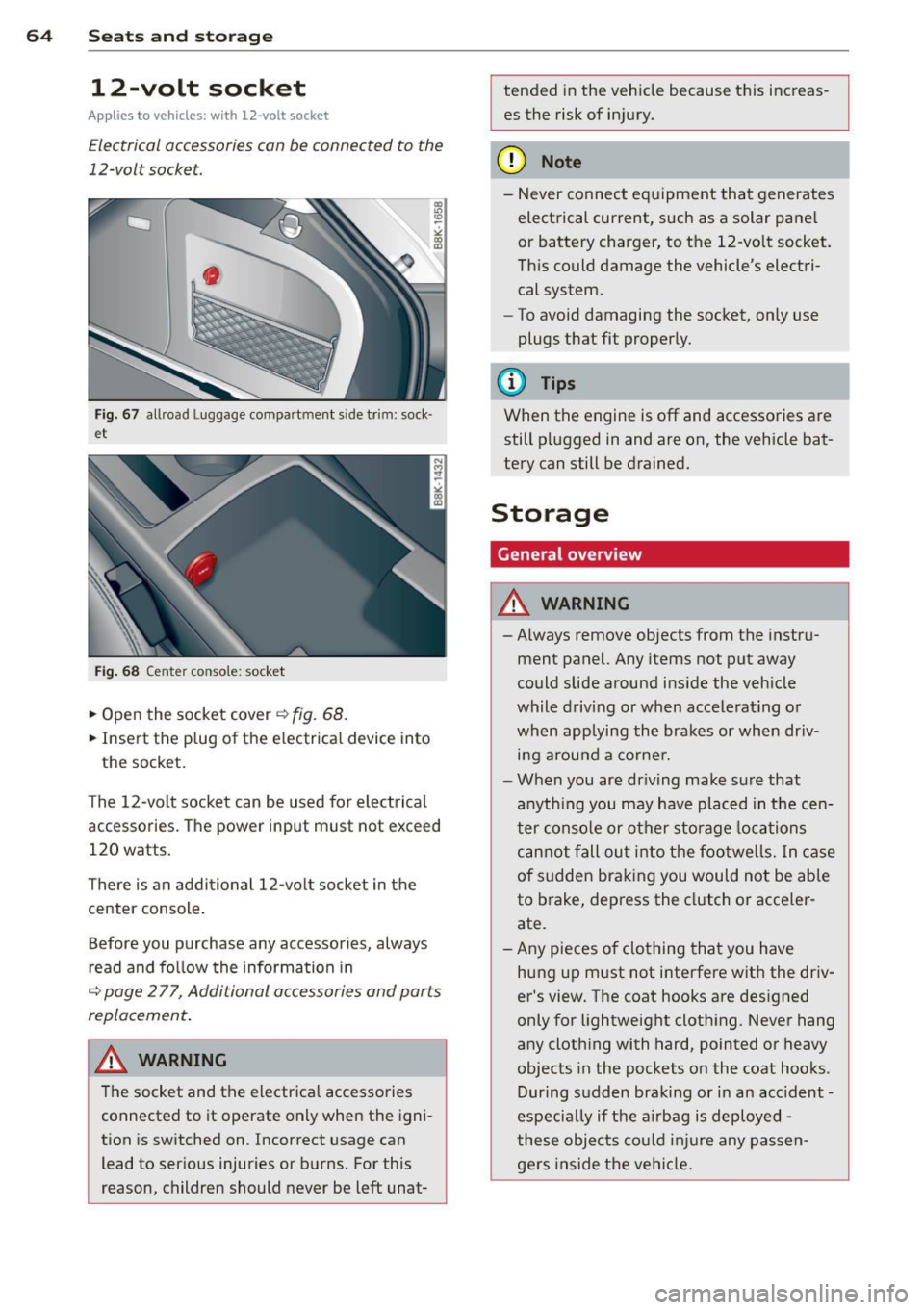
64 Seats and storage
12-volt socket
Applies to vehicles: wit h 12-volt socket
Electrical accessories can be connected to the
12-volt socket.
F ig . 6 7 allroad Luggage compartment s ide trim: sock·
et
Fig . 68 Center conso le: socket
.,. Open the socket cover~ fig. 68.
.,. Insert the p lug of the e lectrical device into
the socket.
The 12-volt socket can be used for elec trical
accessories. The power input must not exceed
120 watts.
There is an addi tional 12-vo lt socket in the
center console .
Before you purchase any accessories, always
r ead and fo llow the information in
~ page 277, Additional accessories and parts
replacement .
.&_ WARNING
The socket and the electrica l accessories
connected to it operate only when the igni
tion is sw itched on. Incorrect usage can
lead to serious injuries or burns. For this
reason, children should never be left unat-
-
tended in the veh icle because this increas
es the risk of in jury.
(D Note
-Never connect eq uipment that generates
electrical current, such as a solar pane l
or battery charger, to the 12-vo lt socket.
Th is could damage the vehicle's electri
cal system.
- To avoid damaging the socket, only use
plugs t hat fit properly.
(D Tips
When the engine is off and accessories are
still plugged in and are on, the vehicle bat
tery can still be drained.
Storage
General overview
.&_ WARNING
-
- Always remove objects from the instru-
ment panel. Any items not put away
could slide around ins ide the veh icle
while driving or when accele rat ing or
when applying the brakes or when dr iv
i n g arou nd a corne r.
- When you are dr iving make su re that
anyth ing you may have pla ced in the cen
ter conso le or other sto rage locations
can not fall ou t in to t he footwe lls. In c ase
of sudden braking you would not be able
to brake, dep ress the clutch o r acce ler
ate.
- Any pieces o f clothing that you have
hung up m ust not interfere with the driv
er 's view. The coat hooks are des igned
only for lightweight cloth ing. Never hang
any clothing with hard, pointed or heavy
objects in the pockets on the coat hooks .
During s udden braking or in an accident -
especia lly if the a irbag is d eployed -
these objec ts co uld inj ure any passen
gers inside the ve hicl e.
-
Page 74 of 296
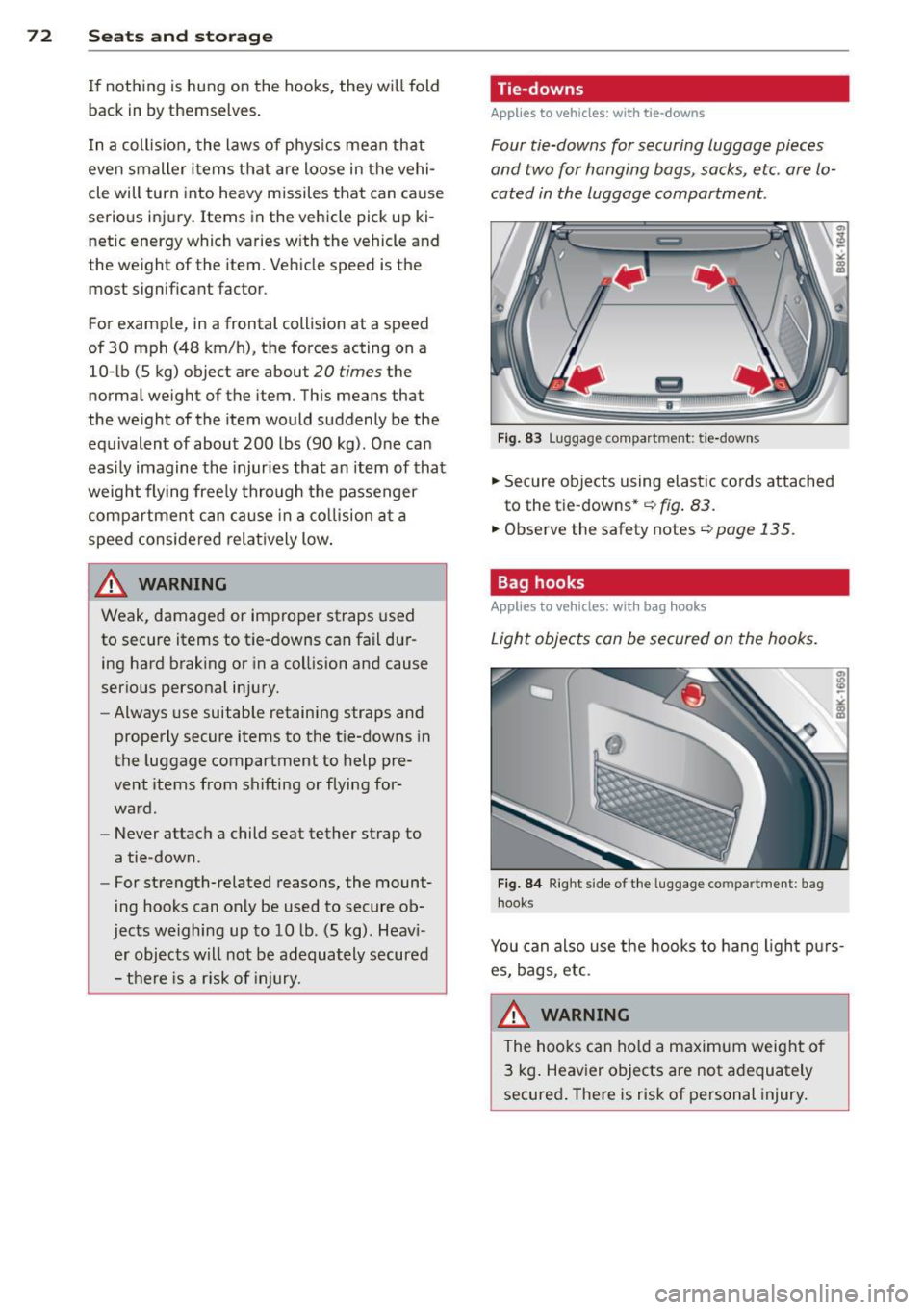
7 2 Seats and storage
If not hing is hung on the hooks, they wi ll fold
back in by themselves .
I n a coll is ion, the laws of phys ics mean that
even smaller items that are loose in the vehi
cle will turn into heavy missiles that can ca use
serio us injury . Items in the vehicle p ick up ki
netic energy which varies w ith the vehicle and
the we ight of the item . Veh icle speed is the
most significant factor .
F or example, in a frontal collisio n at a speed
of 30 mph (48 km/h), the forces acting on a 10- lb (5 kg) object a re about
20 times the
normal weight of the item . Th is means that
the we ight of the item would suddenly be the
equ ivalent of about 200 lbs (90 kg). O ne can
eas ily imagine the injuries that an item of that
weight flying free ly through the passenger
compartmen t can ca us e in a co llision a t a
speed considered relat ively low .
8_ WARNING
Weak, damage d or improper straps used
to secure items to tie -downs can fail du r
ing hard b rak ing or in a col lision and cause
serious personal in jury.
- Always use suitab le retaining straps and
properly secure items to the tie-downs in
t h e luggage compartment to help pre
vent items from shifting or flying for
wa rd .
- Never attac h a child seat tether strap to
a tie -down.
- For st rength-related reasons, the mount
ing hooks can only be used to secure ob
jects weighing up to 10 lb . (5 kg) . Heav i
er objec ts w ill not be a dequately secured
- the re is a r isk of injury.
Tie-downs
Applies to vehicles: with tie-downs
Four tie-downs for securing luggage pieces
and two for hanging bags , sacks, etc. are
lo
cated in the luggage compartment.
F ig . 83 Lu gg age compart ment: tie-down s
,.. Secure o bjects using elast ic co rds attached
to the t ie -downs* ¢
fig. 83.
,.. Obse rve the safety notes ¢ page 135.
Bag hooks
Applies to vehicles: with bag hooks
Light objects can be secur ed on the hooks.
Fi g. 84 R ig ht side of t he lu ggage co mpartment : bag
h ook s
You can also use the hooks to hang ligh t pu rs
es, bags, e tc.
8_ WARNING
The hoo ks can ho ld a maximum weight of
3 kg . Heav ier objects are not a dequately
secure d. There is risk of personal injury.
Page 130 of 296
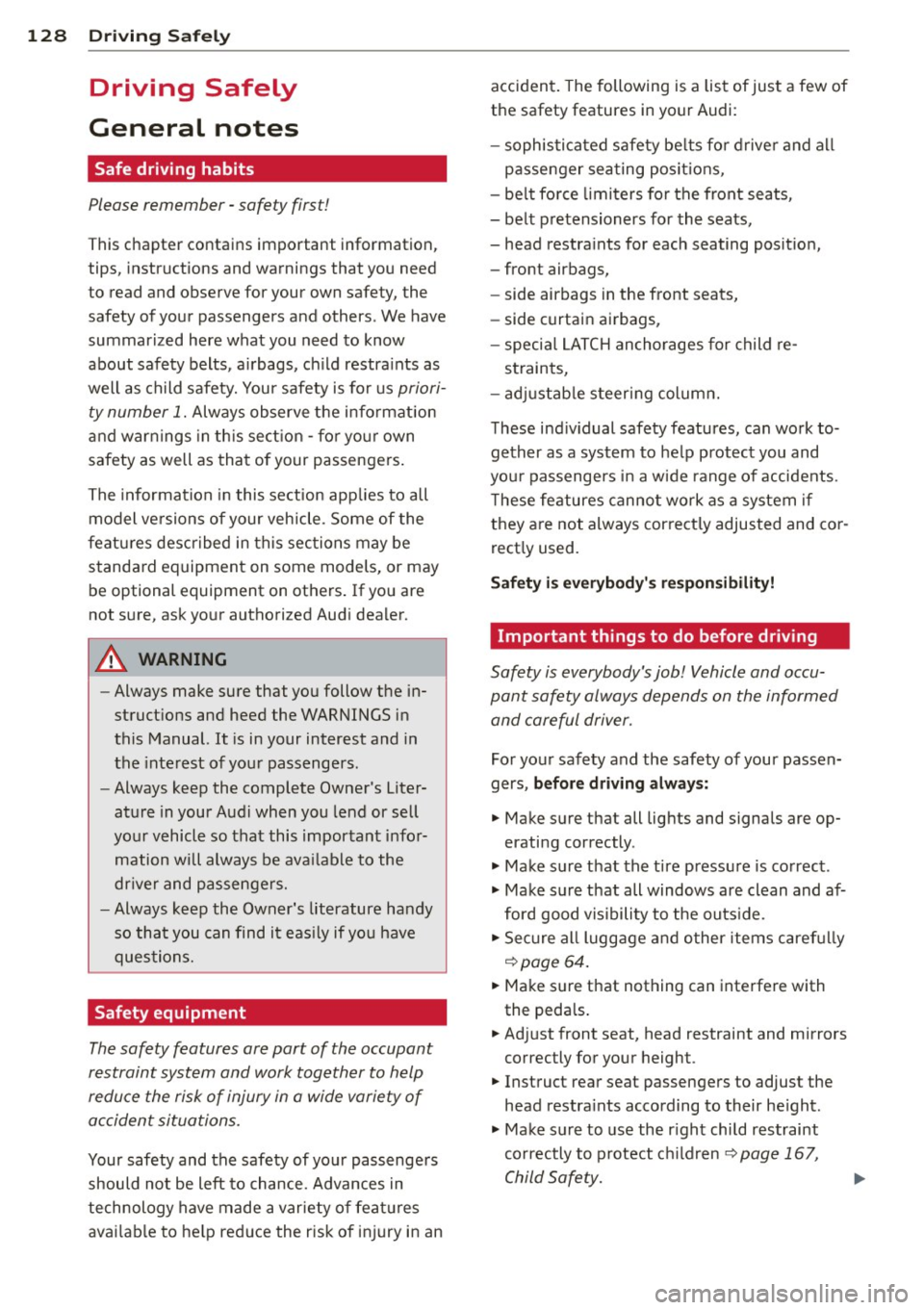
128 Driving Safely
Driving Safely
General notes
Safe driving habits
Please remember -safety first!
This chapter contains important information,
tips, instructions and warnings that you need
to read and observe for your own safety, the
safety of your passengers and others . We have
summarized here what you need to know
about safety belts, airbags, child restraints as
well as child safety. Your safety is for us
priori
ty number 1.
Always observe the information
and warnings in this section - for your own
safety as well as that of your passengers.
The information in this section applies to all
model versions of your vehicle . Some of the
features described in this sections may be
standard equipment on some models, or may
be optional equipment on others. If you are
not sure, ask your authorized Audi dealer.
A WARNING
- Always make sure that you follow the in
structions and heed the WARNINGS in
this Manual. It is in your interest and in
the interest of your passengers.
- Always keep the complete Owner's Liter
ature in your Audi when you lend or sell
your vehicle so that this important infor
mation will always be available to the
driver and passengers.
- Always keep the Owner's literature handy
so that you can find it easily if you have
questions.
Safety equipment
The safety features are part of the occupant
restraint system and work together to help
reduce the risk of injury in a wide variety of
accident situations.
Your safety and the safety of your passengers
should not be left to chance. Advances in
technology have made a variety of features
available to help reduce the risk of injury in an accident.
The following is a list of just a few of
the safety features in your Audi:
- sophisticated safety belts for driver and all
passenger seating positions,
- belt force limiters for the front seats,
- belt pretensioners for the seats,
- head restraints for each seating position,
- front airbags,
- side airbags in the front seats,
- side curtain airbags,
- special LATCH anchorages for child re-
straints,
- adjustable steering column.
These individual safety features, can work to gether as a system to help protect you and
your passengers in a wide range of accidents .
These features cannot work as a system if
they are not always correctly adjusted and cor
rectly used.
Safety is everybody's responsibility!
Important things to do before driving
Safety is everybody's job! Vehicle and occu
pant safety always depends on the informed and careful driver.
For your safety and the safety of your passen
gers,
before driving always:
.,. Make sure that all lights and signals are op
erating correctly.
.,. Make sure that the tire pressure is correct .
.,. Make sure that all windows are clean and af
ford good visibility to the outside.
.,. Secure all luggage and other items carefully
qpage 64 .
.,. Make sure that nothing can interfere with
the pedals.
.,. Adjust front seat, head restraint and mirrors
correctly for your height.
.,. Instruct rear seat passengers to adjust the
head restraints according to their height.
.,. Make sure to use the right child restraint
correctly to protect children¢
page 167,
Child Safety. "'
Page 132 of 296
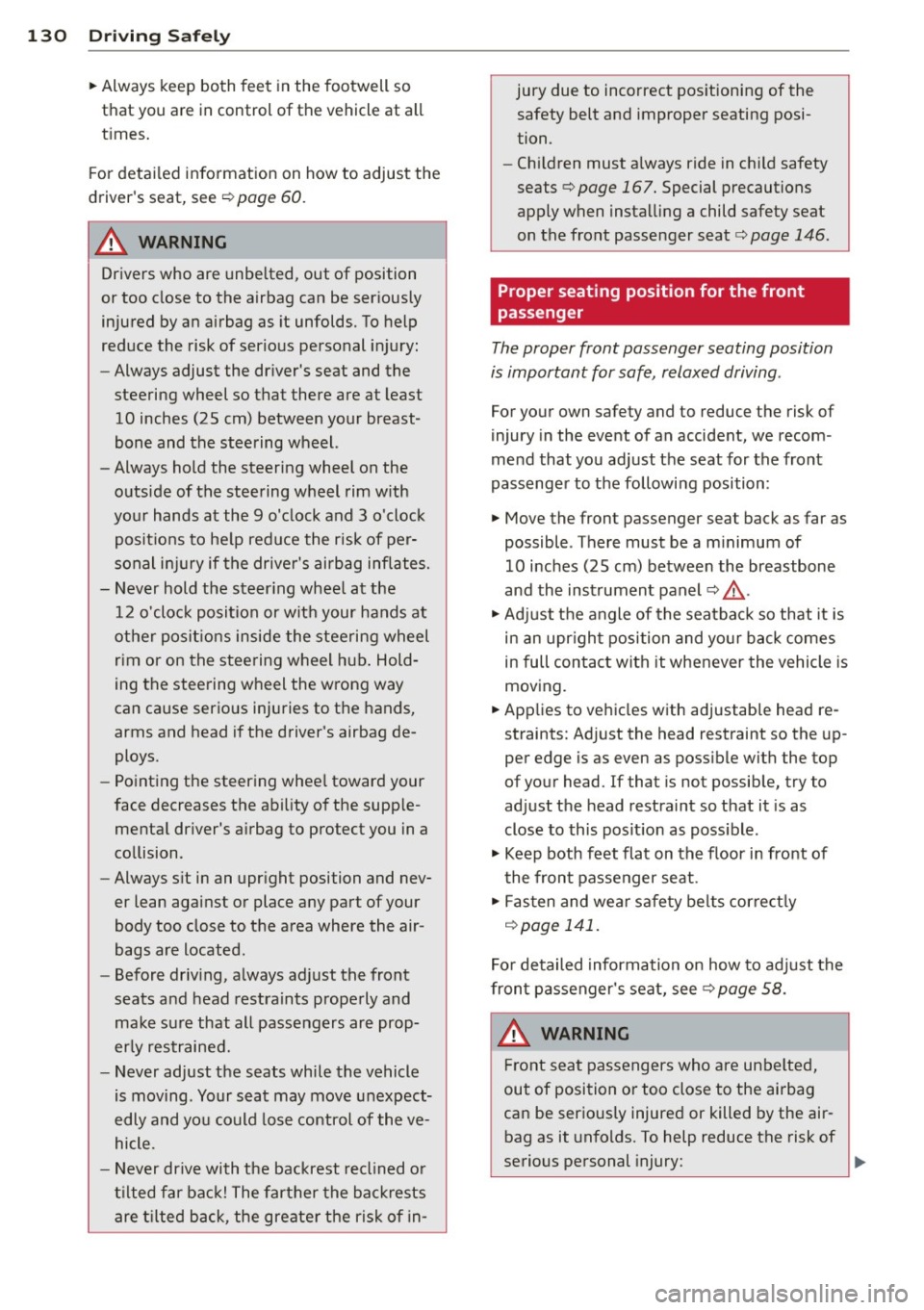
130 Driving Safely
• Always keep both feet in the footwell so
that you are in control of the vehicle at all
times.
For detailed information on how to adjust the
driver's seat, see
¢page 60.
A WARNING
Drivers who are unbelted, out of position
or too close to the airbag can be seriously
injured by an airbag as it unfolds. To help
reduce the risk of serious personal injury:
- Always adjust the driver's seat and the
steering wheel so that there are at least
10 inches (25 cm) between your breast
bone and the steering wheel.
- Always hold the steering wheel on the
outside of the steering wheel rim with
your hands at the 9 o'clock and 3 o'clock positions to help reduce the risk of per
sonal injury if the driver's airbag inflates.
- Never hold the steering wheel at the
12 o'clock position or with your hands at
other positions inside the steering wheel
rim or on the steering wheel hub. Hold
ing the steering wheel the wrong way
can cause serious injuries to the hands,
arms and head if the driver's airbag de
ploys.
- Pointing the steering wheel toward your
face decreases the ability of the supple
mental driver's airbag to protect you in a
collision.
- Always sit in an upright position and nev
er lean against or place any part of your
body too close to the area where the air
bags are located.
- Before driving, always adjust the front
seats and head restraints properly and
make sure that all passengers are prop
erly restrained.
- Never adjust the seats while the vehicle
is moving . Your seat may move unexpect
edly and you could lose control of the ve
hicle.
- Never drive with the backrest reclined or
tilted far back! The farther the backrests
are tilted back, the greater the risk of in- jury due to incorrect positioning of the
safety belt and improper seating posi
tion.
- Children must always ride in child safety
seats ¢
page 167. Special precautions
apply when installing a child safety seat
on the front passenger seat¢
page 146.
Proper seating position for the front
passenger
The proper front passenger seating position
is important for safe, relaxed driving .
For your own safety and to reduce the risk of
injury in the event of an accident, we recom
mend that you adjust the seat for the front
passenger to the following position :
• Move the front passenger seat back as far as
possible . There must be a minimum of
10 inches (25 cm) between the breastbone
and the instrument panel¢,&. .
• Adjust the angle of the seatback so that it is
in an upright position and your back comes
in full contact with it whenever the vehicle is
moving.
• Applies to vehicles with adjustable head re
straints: Adjust the head restraint so the up
per edge is as even as possible with the top
of your head. If that is not possible, try to
adjust the head restraint so that it is as
close to this position as possible.
• Keep both feet flat on the floor in front of
the front passenger seat.
• Fasten and wear safety belts correctly
¢page 141.
For detailed information on how to adjust the
front passenger's seat, see
¢ page 58.
A WARNING
-
Front seat passengers who are unbelted,
out of position or too close to the airbag
can be seriously injured or killed by the air bag as it unfolds. To help reduce the risk of
serious personal injury: